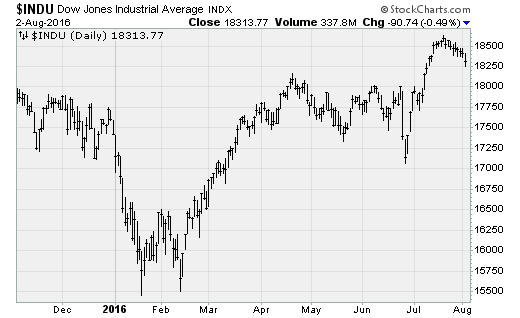Why U.S. stocks have fallen 7 days in a row
The smooth and steady uptrend investors enjoyed out of the late June market low has been replaced by a persistent, nagging selloff.
Tuesday marked the seventh straight loss for the Dow Jones Industrial Average as crude oil closed below the $40 a barrel handle for the first time since April.
Investors have also been disappointed by a weaker-than-expected policy response from the world's central banker following June surprise Brexit vote. Stocks had rebounded in historic fashion merely on the hint and rumor of a possible globally coordinated monetary policy push, which was then narrowed in the days that followed into hopes of a "helicopter money" drop out of Japan (in this case, fiscal spending funded by freshly printed yen).
But the push by U.S. stocks to new record highs in July undercut the need for this stimulus. One by one, policymakers have opted against any further monetary loosening. First, the Bank of England. Then, the European Central Bank. The Federal Reserve was next, and finally the Bank of Japan last week left its overall stimulus pace intact.
Although Japan on Tuesday unveiled a 28 trillion yen stimulus plan, only a portion includes new spending for things like infrastructure building. The stimulus was much less potent than investors expected, pushing Japanese stocks lower in response.
The takeaway is that Prime Minster Shinzo Abe prefers the Bank of Japan to act even more aggressively to boost inflation, no doubt because he feels constrained by a downright terrifying government debt-to-GDP ratio of 229 percent (versus 104 percent for the U.S.).
According to Capital Economics, Japan's measures won't be enough to boost the economy enough to return inflation to the BoJ's 2 percent target. They are looking for merely a 1.3 percent boost to GDP growth at a time when the economy is growing at only a 0.5 percent rate.
Until there is clarity on the matter, and potentially new leadership at the Bank of Japan, what was once a driver of bullish sentiment has now because a drag on confidence. As I write this, the Nikkei is down another 200+ points in what looks like the start of a downtrend to test its February/June lows.
Crude oil has been hit by the reemergence of oversupply concerns amid an inventory glut in gasoline that is pressuring refinery margins and slowing cracking activity, pushing the inventory backlog up the supply chain.
Production is ramping up as short-term supply disruptions fade everywhere, from Nigeria to Libya. Iran is aggressively increasing production thanks to the lifting of export sanctions. Russian production rose 1.8 percent. And Saudi Arabia is showing no signs of backing off of its effort to recapture market share via lower prices.
With hopes fading for a massive new monetary policy stimulus, hard realities like lower oil prices, uneven U.S. economic data, whiffs of inflation, Fed hints that it still plans to hike interest rates this year, and an ongoing corporate earnings recession are dragging stocks away from recent highs.
What comes next will depend, in large part, on the results of the Labor Department's latest jobs report on Friday, along with the impact it has on the odds of a Fed rate hike in September.


